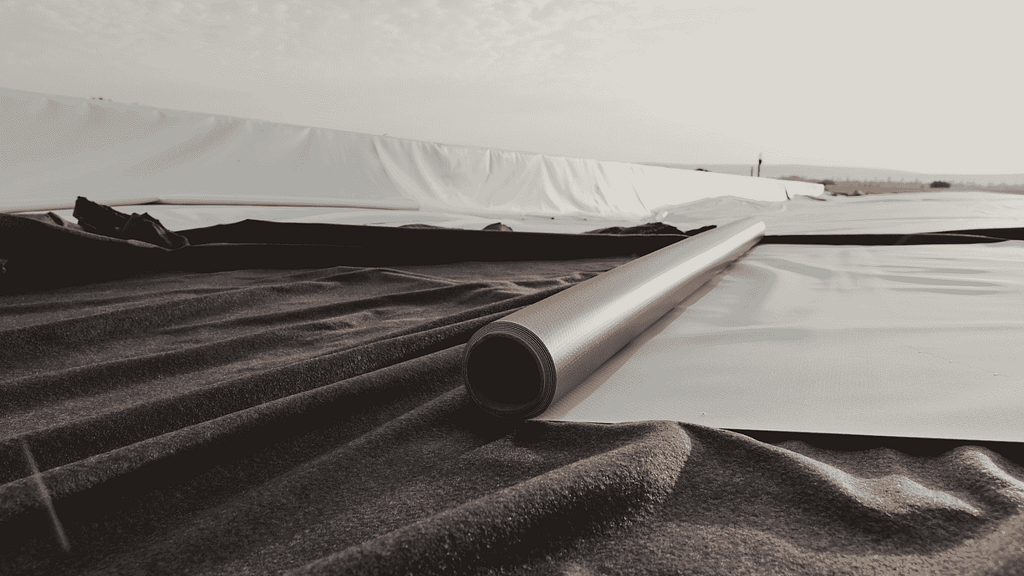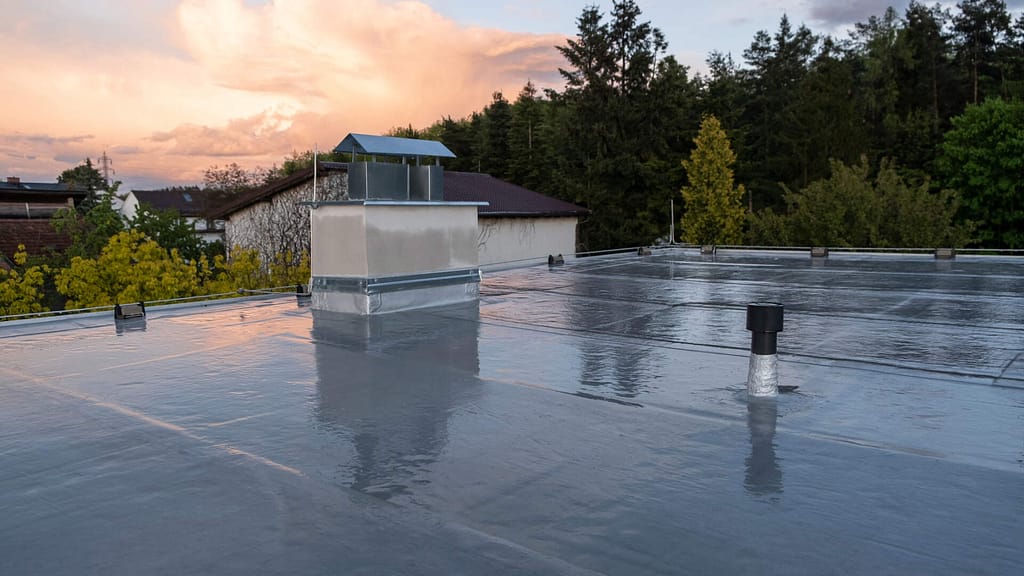A cool roof is a roofing solution designed to reflect more sunlight and absorb less heat than standard roofs, keeping buildings cooler and reducing air conditioning needs.
Table of contents
Concept of a Cool Roof
A cool roof is a special kind of roof that reflects more sunlight and absorbs less heat than a normal roof. Imagine wearing a light-colored shirt on a hot day; it keeps you cooler than a dark one. That’s what a cool roof does for a building. Regular roofs can get really hot, sometimes reaching 150°F in summer. But a cool roof stays much cooler, even more than 50°F cooler in the same heat.
Most cool roofs are also good at getting rid of heat by releasing it back into the air. This ability is called “thermal emittance.” This is great for houses with air conditioning because it means the AC doesn’t have to work as hard to keep the place cool, saving energy and money. In houses without AC, a cool roof makes the inside more comfortable and safer by not letting as much heat inside.
Check out this YouTube video by the U.S. Department of Energy that explains how cool roofs function.
Benefits of a Cool Roof
Cool roofs offer a range of benefits that extend beyond just a building’s interior. A cool roof offers advantages for both a building and those who use it by:
- Lower Energy Bills: Reduces the need for air conditioning, leading to lower energy costs.
- Enhanced AC Performance: Helps older or smaller AC units perform better during hot summers.
- Rebates and Incentives: Potential eligibility for money-saving rebates from utility companies or government programs. Learn more about these issues from the CRRC website
- AC System Downsizing: Allows for the installation of smaller, more efficient air conditioning systems, saving money and enhancing cooling efficiency.
- Improved Indoor Comfort: Increases comfort and safety in non-air-conditioned spaces by keeping them cooler.
- Extended Roof Life: Decreases roof temperature, potentially prolonging the roof’s service life.
- Winter Heating Consideration: It’s important to note that cool roofs can increase heating needs in winter due to less heat absorption.
- Reduced Urban Heat Island Effect: Lowers local outdoor temperatures, helping to mitigate the urban heat island phenomenon.
- Slower Smog Formation: Contributes to reduced smog formation by cooling the outside air (smog formation is temperature-dependent).
- Reduced Electricity Demand: Helps in decreasing peak electricity demand, which can avert power outages.
- Lower Power Plant Emissions: Reduces the demand for energy to cool buildings, leading to decreased emissions from power plants.
- Global Warming Mitigation: Aids in reflecting more sunlight back into space, helping to offset global warming effects.
Types of Cool Roofs
Cool roofs come in various types, each with its own way of keeping buildings cooler. Each of these cool roof types offers a unique way to reduce heat absorption, making them suitable for a range of buildings and climates.
Reflective Coatings
Reflective coatings are a great way to turn a regular roof into a cool roof. These can be applied to many different roofing materials like asphalt, gravel, metal, and single-ply materials. They work by reflecting sunlight away from the roof, which keeps the building cooler.
White Roof Coatings
These are thick, white paints that cover the roof. They’re made of special materials called polymers and white pigments. Because they’re opaque and reflective, they’re really good at sending sunlight back into the sky instead of letting it heat the roof. According to Lawrence Berkeley National Lab Heat Island Group a clean white roof that reflects 80% of sunlight will stay about 31°C (55°F) cooler than a gray roof that reflects only 20% of sunlight.
Pigmented Coatings
Similar to white coatings, these come in colors like red, green, and blue. They’re often used on houses because they look nice while still reflecting some of the sun’s heat.
Aluminum Roof Coatings
This type of coating is made with tiny flakes of aluminum mixed into a resin. It’s like a shiny, metallic layer that goes over the roof. Not only does it hide what the roof is made of, but it also reflects a lot of sunlight and helps get rid of heat.
Elastomeric Roof Coatings (ERCs)
These are made from a type of plastic called acrylic. They’re stretchy, which means they can handle different weather conditions without breaking or cracking. You can put them right on top of an existing roof if it’s in good shape. ERCs are good for flat or slightly sloped roofs, and some types dry really fast after application.
Cool Membrane Roofing

Cool membrane roofing is a special kind of roofing mainly used on flat or gently sloping roofs. You’ll often see it on big commercial buildings, but it’s also used on homes and other buildings that have steeper roofs. The main job of this roofing is to protect buildings from harsh weather and it can also help keep the heat in or out.
Manufacturers use materials such as felt, fiberglass, or polyester to produce this roofing. To classify it as a “cool” roof, they usually cover it with special pigments that reflect sunlight, which assists in keeping the building cooler. In some cases, they also cover the roofing with small stones or gravel.
Types of Cool Membrane Roofing
One popular type of cool membrane roofing is called EPDM, which stands for Ethylene Propylene Diene Monomer. It’s a mouthful, but it’s just a durable rubber-like material. You’ll mostly find EPDM roofing in black or white on lower-pitched commercial buildings. The white version is great for reflecting sunlight and keeping buildings cooler.
Manufacturers make another kind of cool membrane roofing from thermoplastic materials, such as PVC (Polyvinyl Chloride) or TPO (Thermoplastic Polyolefin). These materials form flexible sheets that workers join together through a process called heat welding. Typically, these sheets are white to effectively reflect sunlight, but they are also available in other colors. Thermoplastic membranes suit both commercial and residential buildings well due to their strength and effectiveness in keeping buildings cool.
Cool Roof Options for Different Kinds of Roofs
Cool roofs are designed to reflect more sunlight and absorb less heat than traditional roofs. Depending on the type of roof, there are various cool roofing options available.
Low-Pitched or Flat Roofs

These roofs are almost flat, having just enough slope to let water drain off. Large buildings like warehouses or industrial structures often feature them. For these types of roofs, here are some cool roof options:
- Coated Roofs: These roofs have special finishes applied to them that reflect sunlight. There are various types of coatings available, each with its own set of characteristics.
- Foam Roofs: These consist of a foam-like material formed by mixing two liquids, which then solidify into a solid, lightweight, and flexible layer. It’s a good insulator and reflects sunlight well.
- Built-Up Roofing (BUR) Systems: consist of multi-layered roofs, featuring a base sheet, fabric reinforcements, and a protective top layer. Some BUR systems incorporate reflective materials within their layers, or manufacturers may coat them with reflective substances.
- Modified Bitumen (Mod-Bit): Similar to BUR but more elastic, making it suitable for various climates. It’s based on asphalt and can reflect sunlight effectively.
- Single-Ply Membranes: These are flexible roofing materials, often used on commercial buildings. They can be tailored for reflectivity and are suitable for flat roofs.
Steep-Pitched Roofs
Found mostly on homes, these roofs have a significant slope. Options for cool roofing on steep-pitched roofs include:
- Cool Asphalt Shingles: Manufacturers treat these traditional shingles with reflective materials. They are available in various colors and can have a low Solar Reflective Index (SRI), which is good for reflecting sunlight.
- Slate, Clay, or Concrete Tiles: Common in warmer climates and used globally, manufacturers often treat these materials with reflective coatings. They come in many colors and are durable in extreme weather.
Metal Roofs
Certain finishes can make both low and steep-pitched metal roofs cooler. These finishes enhance the roof’s ability to reflect sunlight and release absorbed heat. For these roof types, consider the following cool roof options:
You can apply reflective coatings to boost their cool roof properties. Choose metal shingles or tiles with factory-applied light or cool-colored paint, or those coated with reflective mineral granules. Avoid unpainted metals; although they reflect sunlight well, they don’t emit heat effectively. This inefficiency causes them to become hotter in the sun compared to painted metals with similar reflective properties.
Cool Roofs and Building Regulations
In California, there are specific rules about cool roofs, especially when it comes to building new structures or replacing roofs. For buildings with low-sloped roofs, the state’s building energy efficiency standards, known as Title 24, require that these roofs be cool roofs. This rule also applies to steep-sloped roofs in several climate zones within California.
We recommend before getting a cool roof in Calfornia to check California roof replacement costs.
To help with these regulations, there’s an organization called the Cool Roof Rating Council (CRRC). This is an independent, non-profit group that runs a program to rate the reflective properties of roofing products. These properties include how much sunlight the roof reflects (solar reflectance) and how well it releases absorbed heat (thermal emittance). When the CRRC rates a roofing product, it posts the results in an online directory. This Rated Products Directory is a handy tool for anyone who needs to check if roofing products meet the requirements of Title 24 or other building codes and standards.
If you’re looking for roofing products that meet specific standards for solar reflectance, thermal emittance, and the Solar Reflectance Index, you can search through the CRRC’s Rated Products Directory. This directory makes it easier to find products that comply with the necessary regulations for cool roofs in California.
Conclusion
In summary, cool roofs are a great choice for homes and businesses. They work by reflecting sunlight and getting rid of heat, which makes indoors cooler. This means lower energy bills because you use less air conditioning, better working AC systems, and more comfort in rooms without AC. Not only do they help save money, but cool roofs are also good for the environment. They reduce city heat, slow down smog, and help fight against climate change. If you’re considering a new roofing project or planning to replace an existing roof, it’s time to think about opting for a cool roof.
Fact checked by Adrian Catalico – 1/25/2024
